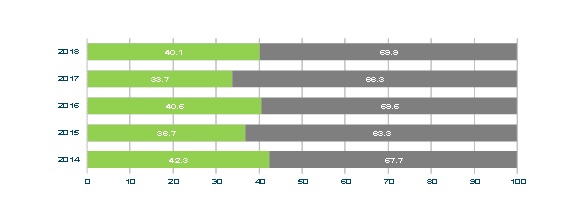We are a global operator of essential infrastructure
- The weight of wind power within the renewable generation structure stood at 49%, with wind accounting for 19% of the annual electricity generation mix.
- Peninsular electricity demand reached 253,495 GWh last year, 0.4% more than in 2017.
- The quality and security of the electricity supply was in line with reference levels, registering an Average Interruption Time (AIT) of less than 0.7 minutes.
Peninsular electricity generation coming from CO2-free emission technologies reached a share of 62.5% in 2018, compared with 57% in 2017, representing an increase of 5.5 percentage points. This increase in clean generation led to a 15% reduction in CO2 emissions: going down from 63.8 million tonnes in 2017 to 54.2 million tonnes in 2018. With regard to combined cycle and coal-fired technologies, these have decreased their share in the electricity generation mix year-on-year by 22% and 18%, respectively.
Nuclear energy (20.6%) continues occupying the first position in the generation mix, nonetheless in 2018 it was followed closely by wind energy (19%). As a whole, the share of renewable generation on the peninsula increased from 33.7% to 40.1%, representing a growth of 6.4 percentage points. In the complete set of technologies that make up the renewable generation structure, wind produced 49%, hydro 34%, solar 11%, and the remainder of the technologies accounted for 5%.
"This significant increase in renewable generation and the consequent reduction in CO2 emissions indicate that Spain is committed to and is on the path towards a new energy and economic model based on decarbonisation and long-term sustainability; and these achievements represent a clear indication of the commitment of the Spanish electricity sector to the European targets regarding the fight against climate change" stated the Chairman of Red Eléctrica de España, Jordi Sevilla, during the presentation of the Spanish Electricity System - Preliminary Report 2018.
Rewnewable/non-renewable generation 2014-2018

The Canary Islands, increasingly more and more renewable
Currently, renewable energy represents 46.7% of the installed power capacity in Spain, up 0.8% on last year. Noteworthy is the case of the Canary Island, where installed wind power capacity increased from 207 MW in 2017 to 422 MW in 2018. The most significant increase was in Tenerife, where it increased from 60 MW to 196 MW, more than triple the previous total. This increase in wind power capacity has enabled wind power generation to go up from 4.4% in 2017 to 7% in 2018.
The promotion of renewable energy in the archipelago is included within the framework of the Canary Islands Wind Energy Plan, initiated in 2010 and scheduled to be completed for 2020. Thanks to the efforts of Red Eléctrica de España and its firm commitment to comply with the deadlines for the construction and commissioning of new infrastructure for the evacuation of renewable energy, the transmission grid on the Canary Islands has been the one that has increased the most: at the end of 2018, the transmission grid in the Canary Islands had 135.4 new km of line circuit and 68 new substation bays. Nationwide, last year the Spanish transmission grid commissioned 276.8 km of line circuit in addition to 149 new substation bays.
Demand for electricity grew for the fourth consecutive year
The demand for electrical energy on the Spanish peninsula reached 253,495 GWh in 2018, a value that is 0.4% more than in 2017, representing four consecutive years of increase compared to previous years. After factoring in the influence of seasonal and working patterns, demand grew by 0.3%.
With regard to the electricity consumption of large and medium-sized companies, this indicator registered a fall of 1.8% in 2018 compared to the previous year. This fall can be deduced from the 2018 data of the Red Eléctrica Index (IRE), which is included in the Spanish Electricity System - Preliminary Report 2018. This index analyses the data regarding the electricity demand of more than 23,000 large power consumers, defined as those that have a contracted power of over 450 kW; a consumer group which represents around 45% of the total electricity demand on the peninsula.
As in the case of the electricity demand, the influence of seasonal and working patterns is also taken into consideration. After having factored it in, the consumption of these companies registered a decrease of 1.3% year-on-year. By sector, the adjusted demand of large consumers in the industrial sector was 2.5% lower, while that of the services sector increased 0.6%. The adjusted demand of other sectors such as agriculture, fishing, construction or extractive/mining, among others, together grew 3.1% compared to 2017.
Lastly, noteworthy is the fact that the quality and security of the electricity supply remained in line with reference levels, registering an Average Interruption Time (AIT) of less than 0.7 minutes.














